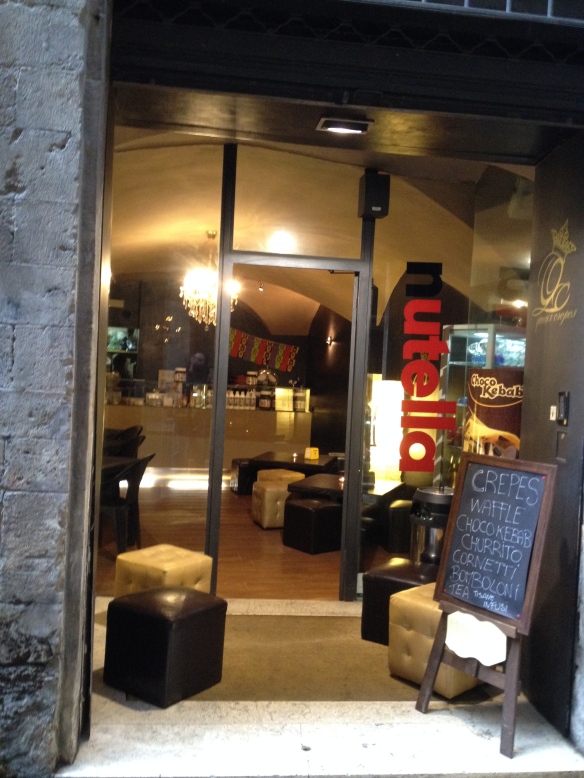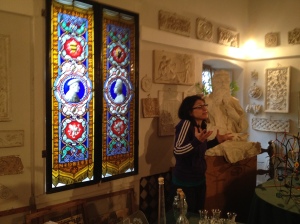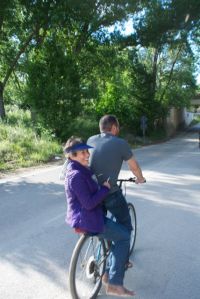
My Perugia room is on the Way of the Witches. Just go behind the freestanding sign, then under the Ristorante La Taverna sign. Look for the unluckiest number you can think of if you’d like to find the apartment where I’m staying. Ring the bell and you may find me here. (The black line in the middle is a sign that the photographer was too lazy to stand up and move around the narrow rope holding down the sun umbrella adjacent to his lunch table.)
I was sad to say goodbye to my gracious host, Alec, and his lovely guest house this morning, but it was time to head to Perugia and find my new abode. Months ago when I chose to study at Comitato Linguistico in Perugia, I knew I’d want to live with an Italian family rather than find a simple (i.e. lonely) studio apartment. The goal was to get as complete an immersion into Italy as possible, and everyone seemed to agree that living with a family is the best means to that end.
After driving to the Perugia Airport to drop off my rental car I took another €30 cab, this time into the heart of Perugia. The day was very sunny, and as the cab driver zipped through the Perugia suburbs I knew right away I would enjoy this town. He drove me to the top of the hill, just a few blocks from the cathedral, at the foot of the pedestrian mall, dropping me at the start of Via Luigi Bonazzi, the pedestrian mall at the center of the old city.
First impression of central Perugia: sweet. The city is mouldering in a charming way, like most Italian towns. The buildings are of stone or plaster-covered stone and where the plaster is painted it is stained, faded or peeling. The pedestrian mall has a Sunday flea market on one end and in the length going to the cathedral is dotted with the shaded, outdoor eating areas of a dozen or so restaurants. Waiters (no waitresses) stand at the doors of their establishments, ready to help anyone who’d like some food to accompany their people-watching. It’s afternoon, so many of the stores are closed, but clearly the gelato emporiums are open since motorcyclists, carabinieri and grandmothers have cones of the chilly delight in their hands as they walk by.
The cab driver pointed me to the Via delle Streghe, location of my room. I’d looked up the meaning of the street name back in Seattle and had to chuckle when I learned it meant, “The Way of the Witches.” I’ve come a long way from being a Methodist pastor one week to living on Witch Street the next. After finding the street and the doorbell I was to ring at 3:00, I settled down for a noon lunch at a restaurant across the street.

The Way of Witches — Is it a narrow street or wide stairway? Either way I plan to follow the sage advice of the graffiti artist.
Four twenty-something students from the U.S. sat at the table next to me and I couldn’t help but overhear their conversation — “got drunk last night . . . woke up with a hangover . . . couldn’t find my cigarettes this morning . . . that boy’s cute.” While I’m in Perugia will I miss conversation in English? Maybe not.
A little later a group of 30 or so English-speaking students strolled by, with a teacher or tour guide pointing out helpful stores — Vodaphone, the bookstore, etc. Obviously Perugia is earning its reputation as a university town that specializes in teaching foreigners the secrets of the Italian language.
The waiter at the restaurant is nice enough to let me chill out at one of his tables for the 3 hours I’ll need until my room is ready. I enjoy a meal of mixed salad and Margherita pizza as I wait, watching the crowds. Theresa Elliott will be interested to know that there was not one local woman with grey hair who passed by in three hours. Apparently the hair of Italian women comes only in black, brunette and blonde whether they are 18 or 80 years old. They are also smartly dressed on this Sunday-take-a-walk afternoon.
Because they notice a photo I’ve posted of my arrival, I connect on Facebook over lunch with some of the local Italians who work for the Umbrian Tourist Office on the St. Francis camino. Gigi, a young fellow who lives in Assisi looks forward to a meeting later. Chiara, a woman closer to my age, asks if I have plans today. An American pilgrim, Kenneth, is in Assisi now, but we’ll meet while he’s here, preparing for his Franciscan walk.

A comfy room for the next 4 weeks.
The time to walk the Way of Witches finally arrives, so I ask for the bill and head down the wide stairway to find the house number. It turns out “my” building on the Way of Witches is a mid-1960’s, brick, multi-story apartment house, hidden from view by the much more quaint 16th and 17th century buildings on the pedestrian mall. A modern apartment has some advantages and I ring the bell to the gate with a sense of excitement.
Soon I hear a voice from a balcony above. “Sandy! Four!” and I see a woman I’ll soon know to be Graziella, my hostess, waving four fingers at me. I go through the building door, up a tiny elevator, and find a smiling and gracious Graziella and her former tenant, Katia, awaiting me at the door of a spacious and airy fourth floor apartment.
Graziella shows me to my place, a large bedroom on the back side of the apartment. She then tours me through the bathroom (tub with handheld shower in the Italian style) and describes in detail everything I should know. Sadly, she speaks only Italian so I don’t understand a word she is saying. I respond in Spanish and pretty soon we’re having a rudimentary conversation about me not eating meat and how I like eggs, croissants, coffee and Nutella® for breakfast. I go to the living room and reintroduce myself to Katia, who’s from Finland and speaks very good English. We go through the same details all over again, this time and with Katia’s words I start to understand. Here’s the key, always double lock the front door. Here’s the cat, keep your bedroom door closed. Breakfast is whatever time you want it. Dinner is 8:00ish.

Graziella, left, and Katia. Witch Way is not named after either of these kind ladies.
We have a few moments for pictures and I take one of Graziella and Katia in the living room. I adjourn to the bedroom and begin to unpack my few possessions into the closet and bureau. I brought several books, but as I unpack I realize how few pants I have, plus just a few t-shirts. Today is Sunday and the stores are closed, but maybe I’ll get a pair of shorts tomorrow. I have a tiny bag of laundry and I make a mental note to learn the Italian word so I can ask Graziella about it later.
I can already tell that this adventure is going to be, well, an adventure. Tomorrow I’ll go to Italian school for the first time and hopefully meet some people. I’ve scoped out the comfortable side chairs near my bed where presumably I’ll do my reading. I spread out my electronics on the desk to start recharging my various batteries. I logged onto the WiFi and, all these things accomplished, I begin to relax, feeling instantly sleepy. These 4:00 mornings can’t last much longer. I need a good night’s sleep and an end to this jet lagginess of the last days.
Later on I’m sure I’ll meet my Facebook friends Gigi, Chiara and perhaps Kenneth. I’m sure other surprises await, but for now I’m glad to have found my new, temporary home so I can dig into this work of studying Italian here on Witch Way.

View from my window, above which way?






































































































